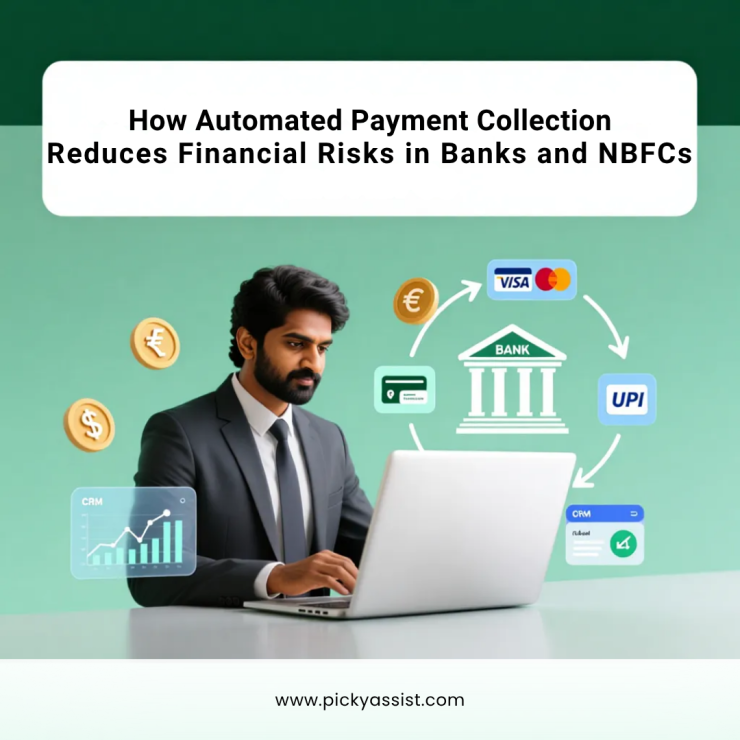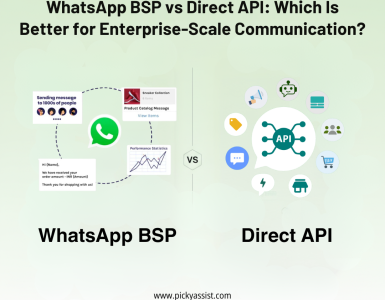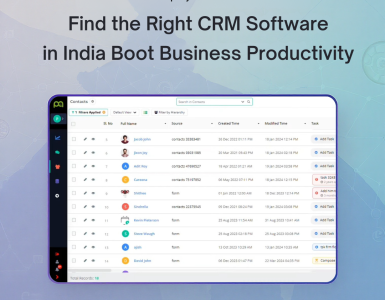In the banking and NBFC space, delayed payments and defaults pose major financial risks. Traditional manual payment collection methods like call centers, mailed reminders, tedious reconciliation etc drive up costs and create inefficiencies. The answer? Automated payment collection. With the right system in place, institutions can cut delinquencies, boost cash flow, and streamline recovery processes. In this article, we explore how automated payment collection addresses key pain points, the components of a robust solution, and how businesses can benefit without needing deep technical expertise.
Why Payment Risk Matters?
Before diving into solutions, consider some hard facts:
- A small increase in the delinquency rate (say 1 %) can erode net interest margins significantly.
- Many banks and NBFCs report 20–40% higher recovery rates when using automation and analytics in collection workflows.
- Manual processes are prone to human error, miscommunication, and delay, all of which amplify risk as debts age.
Hence, reducing payment risk is not just about chasing dues, it’s about preserving profitability, protecting regulatory compliance, safeguarding reputation, and enhancing customer relationships.
Key Components of a Risk-Reducing Framework
To reduce payment risk effectively, banks and NBFCs should adopt a multi-layered automation approach. Below are the core pillars:
1. Automated Payment Collection & Reminder Messaging
The central engine is automated payment collection—setting up recurring mandates, auto-debits, digital invoices, and reminders without manual triggers. A well-designed automated payment collection system ensures that payments are initiated and followed up without human intervention. Integrated automated payment reminder features (SMS, email, WhatsApp) nudge customers just before due dates, reducing missed payments.
2. Smart Debt Collection and Prioritization
Not every overdue account deserves the same treatment. Modern platforms offer automated debt collection software that uses rules or AI to segment accounts. For example, high-value defaulters may trigger direct calls, while low-value ones receive automated messages or emails. This automated debt collection approach increases efficiency and recovery rates, especially when combined with predictive analytics.
3. Automated Cash Collection & Reconciliation
Once payment is triggered, the system must support automated cash collection, record receipts, and reconcile funds with outstanding balances. This avoids manual reconciliation and errors, and ensures the finance ledger aligns in real time.
4. Role-Based Assignment and Team Collaboration
Even in an automated world, complex cases need human intervention. This is where concepts of Debt Collection System workflows, team assignment (e.g., via a Teambox-style module), and issue escalations come into play. Chats or cases can be dynamically assigned to the right specialist without losing context.
5. Monitoring, Analytics & Feedback Loops
Finally, you need dashboards to track success: collections by channel, overdue aging buckets, recovery rates, and channel effectiveness. Closed-loop feedback lets you refine campaign strategies over time.
Implementation Without Heavy IT Lift
One major barrier for many institutions is the technical overhead. But today, solutions like Picky Assist enable deployment of automatic payment collection workflows, chatbot triggers, and reminder automation with minimal coding. Let me explain how:
- Using a visual interface, you can build conversational flows that prompt users for payment links and trigger collections.
- The system offers pre-built modules for mandate management and auto-debits.
- With AI-Powered Collection Automation Software capabilities, the platform can intelligently decide which customers receive reminders, or escalation paths.
- You don’t need to build WhatsApp APIs from scratch, the integration with payment gateways is plug-and-play. Picky Assist supports integration with PayU, Stripe and Razorpay.
- The tool can also act as an automated pay system, seamlessly initiating collection instructions when conditions are met.
New from Picky Assist: WhatsApp Payment Automation lets businesses collect payments directly inside WhatsApp using WhatsApp Pay or secure payment links. The process is fully automated, from sending payment requests, to customers completing payments without leaving the chat, to instant confirmation and reconciliation. It even supports bulk payment requests via Excel upload, recurring payment reminders, and global payment links for regions where native WhatsApp payments aren’t available. All of this works in concert with Picky Assist’s chatbot, broadcaster, CRM, flow builder and workflow modules, meaning it’s not just a payment module but part of a full automated payment collection system. Thus, you sidestep the traditional multi-month IT project and go live quickly.
Benefits and Impact
Let’s look at concrete advantages of deploying automated payment collection in banks and NBFCs:
| Benefit | Impact / Statistic* |
| Higher recovery rates | 20–40 % uplift reported when layering automation in collections workflows |
| Reduced operational cost | Lower staff workload, fewer manual tasks, better scalability |
| Lower error & compliance risk | Rule-driven workflows minimize human slips |
| Better customer experience | Personalized, timely reminders feel less intrusive than repeated calls |
| Faster cash flow | Automated debits and payment reconciliation accelerate fund realization |
* Based on industry reports and case studies.
Because the system works continuously (24/7), it ensures no customer is missed simply because staff are offline.
Use Case Scenario: During a Discount Campaign
Imagine a bank offering a seasonal interest waiver or discount period. You want to ensure all delinquent customers get a gentle nudge. With automatic payment collection in place:
- A broadcaster tool pushes a message (via SMS/WhatsApp) to the relevant segment — effectively an automated payment collection outreach campaign.
- The message includes a secure link or mandate instruction to pay.
- Those who click are guided through a chatbot-powered flow that triggers the collection request.
- Cases that fail (e.g. payment bounce) are escalated to human collectors via the Debt Collection System module.
- Teambox-style assignment ensures the right collector handles each case promptly.
All this happens with a few clicks and zero manual follow-up.
Practical Steps to Deploy
To get started on a robust automated payment collection strategy, follow these recommended steps:
- Define your overdue segments & thresholds – Determine which customers go into automated flow vs. which need human review.
- Select a modular platform – You can consider choosing Picky Assist that supports automated payment systems for small businesses and scales to enterprises.
- Map the flow – Design the flow for reminders, retries, fallback to human channels.
- Integrate with payment gateway / auto-debit – So the platform can initiate real collection calls. Picky Assist support integration with PayU, Razorpay and Stripe.
- Test with pilot group – Validate behavior, monitor success rates, adjust messaging cadence.
- Tune with analytics – Use dashboards to refine segmentation, timing, channel mix.
- Scale & monitor compliance – Ensure communication remains within regulatory boundaries.
By iterating smartly, you gradually reduce delays and defaults.
How Picky Assist makes a Difference?
While many platforms offer components of automation, Picky Assist brings these together in one unified suite:
- You can build a full automated debt collection software flow using visual drag-and-drop tools.
- It supports automated cash collection via integration with payment gateways.
- The automated payment collection system is ready to launch without requiring heavy development.
- With built-in automated payment reminders (SMS, email, WhatsApp), it nudges customers proactively.
- A Teambox-like chat assignment module helps you allocate exceptions and escalations naturally.
- Its broadcaster and segmenting features allow you to send bulk messages during offers or discount periods.
- Because it’s modular and AI-enhanced, the platform evolves as your collection maturity increases.
In short: Picky Assist enables risk reduction via automated payment collection in a practical, implementable way.
Conclusion
In an era where margin pressure and credit risk loom large, automated payment collection is essential. It transforms collections from a cost center to a competitive differentiator, enabling banks and NBFCs to recover more, reduce errors, and deliver superior customer experience. By pairing automation with analytics, segmentation, and streamlined workflows, institutions can mitigate risk proactively.
For businesses looking to adopt this in practice, Picky Assist offers a turnkey path to deploying automated payment collection tools, without requiring deep coding or months of integration. The future is automated: the sooner you get there, the lower your exposure to payment risk.
FAQs on Automated Payment Collection
1. What is the automated payment process?
The automated payment process is a set of digital workflows that schedule, trigger, and execute payments (e.g. via auto-debit or mandate) automatically, without needing manual input each time. It may include reminders, retries, and reconciliation logic.
2. What is an automated collection system?
An automated collection system is software that handles follow-up, reminders, segmentation, escalation, scheduling, and reconciliation for overdue payments. It combines digital outreach and rules-based logic to manage debt recovery processes.
3. How to collect automatic payments?
You collect automatic payments by (1) obtaining proper mandates or authorization from customers, (2) scheduling auto-debits or recurring instructions, (3) sending reminders, (4) triggering payment and monitoring success, and (5) reconciling funds in your ledger system.
4. What is an automated payment?
An automated payment is a payment executed without human intervention, triggered by rules, schedules, or events. Examples include recurring bills, subscription charges, or auto-debit of loan EMI.
5. What is payment automation?
Payment automation is the broader process of automating end-to-end payment workflows, including invoice generation, reminders, execution, failure handling, and reconciliation.
6. What is an automated transaction?
An automated transaction happens when a system executes a payment or fund transfer based on configured logic, without needing a person to manually initiate it.







Add comment